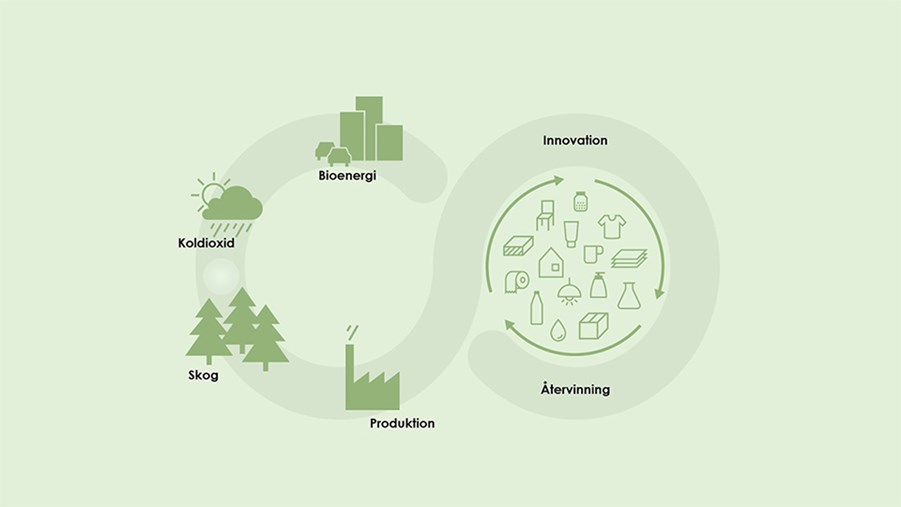
What is sustainable forest management?
How is sustainable forest management defined? And how can it become an important driver in climate efforts?

The forest's green carbon cycle is fundamental to life on Earth. How does this carbon cycle work, and where do forest products fit in? Researchers Johan Bergh and Tomas Lundmark share their views.
Carbon circulates in a biogenic ecocycle between the forest, society and the atmosphere. Growing trees and other vegetation capture the air's carbon dioxide and the sun's energy and transform them into wood and other biomass. Some trees are harvested and become products, such as newsprint and wooden houses. Those that are not harvested are broken down by microorganisms and fungi. Whether the trees are turned into products or rot in the forest, the carbon dioxide they absorb is released – sooner or later – and goes back into the atmosphere where it once again becomes available to plants. The ecocycle is closed.
Tomas Lundmark, Professor of Forest Management at the Swedish University of Agricultural Sciences in Umeå, northern Sweden, says that many people mistakenly see the forest as a '"bucket" for carbon dioxide, somewhere we can store all the excess carbon dioxide in the atmosphere:
"But we can't store an unlimited amount of carbon dioxide in the forest, for an unlimited period. Instead we need to free ourselves from fossil dependency, which is the biggest cause of carbon atoms entering the ecocycle. We need to stop that addition of carbon first, and that can't be achieved by no longer using the forest."
Lundmark says that it is a common misconception that a large carbon stock means extensive climate benefits. But in actual fact size is not important here; it is the change in the carbon stock that creates the climate benefits.
"If we stop harvesting forest growth to build the carbon stock in the forests, the consequence is increased fossil dependency resulting from demand being met by more fossil products, rather than the forest products that would otherwise be produced," Lundmark explains.
Some claim that the carbon dioxide is the same whether it comes from fossil sources (fossil carbon dioxide) or combustion of biomaterials (biogenic carbon dioxide). Chemically speaking the molecules are exactly the same, but there is in fact a huge difference.
"When we burn wood, it releases carbon dioxide that previously existed in the atmosphere. No new carbon is added to the ecocycle. Carbon from fossil sources, however, is taken from the carbon stock that has been buried in the earth's crust for hundreds of millions of years. This adds new carbon atoms to the atmosphere and increase carbon dioxide levels there," says Johan Bergh, Professor in Forest Management focusing on the forest's climate benefits at Linnaeus University, Växjö, southern Sweden.
How well the forests are managed today has a great impact on what the climate will be like in the future. Well-management forests can further increase photosynthesis, which encourages growth and thereby sequestration of carbon in the forests. Another key is to do more of the good work that is already being done, according to Professor Bergh:
"Plant the right tree species in the right ground, harvest at the right time and regenerate the forest. We also need to use the majority of the constantly increasing carbon stock – not only so that we can store carbon in more robust, long-term products such as buildings and prevent emissions of carbon dioxide from fossil energy, but also to maintain a higher level of annual growth in the forests."
He says that we also need to reduce the risk of forest fires, damage caused by game, insect infestation and fungal diseases, so as to boost growth and keep the trees vital.
In order to mitigate climate problems, fossil emissions need to decrease. One effective solution is to replace fossil based products and energy with renewable alternatives – i.e. products from forests or agriculture – a process known as substitution. In practical terms this entails substituting energy-demanding concrete and steel with wood raw materials, plastic packaging with paper based packaging, oil based textile such as polyester with cellulose textile fibres, and coal and oil with bioenergy.
"Substitution is a lasting solution, so use the forest raw material rather than letting it stand as a carbon store. The harvested tree should be used in the most resource-efficient way possible, to create the highest possible degree of substitution and storage in different long-living wooden products," Johan Bergh concludes.
Storgatan 19
Stockholm
Box 55525, 102 04 Stockholm, Sweden
+46 (0)8-762 72 60
We use cookies to improve your browsing experience (Swedish text)
Privacy policy (Swedish text)